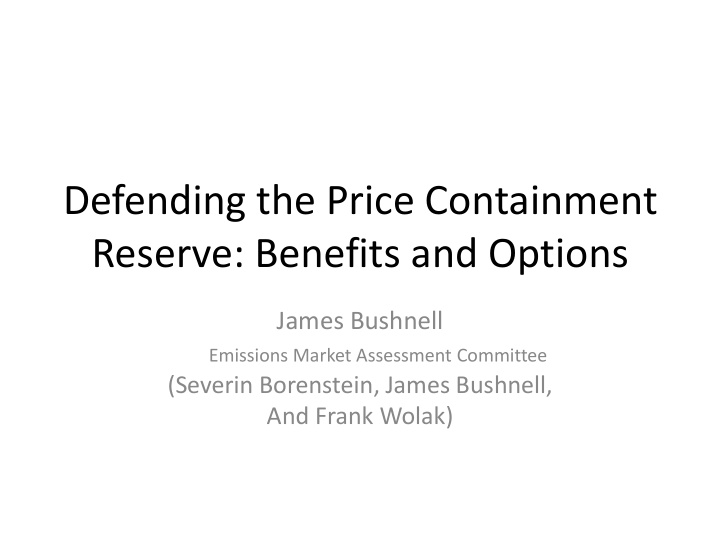



Defending the Price Containment Reserve: Benefits and Options James Bushnell Emissions Market Assessment Committee (Severin Borenstein, James Bushnell, And Frank Wolak)
Benefits of Defending Containment Reserve • Limits the possible price and economic impacts from volatility in supply or demand – Especially if abatement supply is very inelastic • Avoids possible market disruption if shortage occurs near end of market period (2020) • Eliminates price increase that incorporates low probability of skyrocketing price • Eliminates incentive to push price above current reserve levels through market manipulation 2
Allowance Price Probabilities by Scenario 100%� o 3%� 5%� 9%� 9%� 11%� 5%� 13%� 5%� 16%� 17%� 1%� 90%� 1%� 22%� 4%� 8%� 1%� 8%� 1%� 10%� 1%� 80%� 12%� 13%� 1%� 10%� 3%� 70%� 3%� 3%� 60%� 50%� 91%� 89%� 86%� 82%� 40%� 80%� 76%� 69%� 67%� 65%� 30%� 20%� 10%� 0%� S1:� Med� S2:� 75th� S3:� Max� S4:� Med� S5:� 75th� S6:� Max� S7:� Med� S8:� 75th� S9:� Max� Demand� Demand� Demand� Demand� Demand� Demand� Demand� Demand� Demand� Low� Abatement/Allowance� Supply� Medium� Abatement/Allowance� Supply � High� Abatement/Allowance� Supply� pr(flo r )� pr(upslope)� pr(inreserve)� pr(abovereserve)�
Cost Containment and Allocation • Allocations through output-based updating dilute the impacts of allowance prices – Reduce the responsiveness to allowance prices. – Can be acceptable side-effect for trade-exposed industries with options for reducing CO2 intensity. – Makes no sense for emissions related to end-use fuel consumption (e.g. gas). • Diluting incentives provided by allowance prices is not true cost-containment. – Can be counter-productive by making high allowance prices more likely and raising the economic costs of abatement.
Principles for Price-Containment • Should be ex-ante transparent – A deterrent only works if market knows it exists • Should be credible – A hard quantity cap is not credible if the prices that result are unsustainable • Should be timely – Measures need to kick in immediately to avert disruption • Should consider broad environmental benefits instead of narrow ones – Environmental integrity of global pollutant involves more than just capped CA (or WCI) emissions
ARB Options • We believe there is a non-trivial possibility current reserve could be exhausted – Would not support the do nothing option • Delay or cancellation of compliance obligations would be disruptive and harmful to the program – Significant equity impacts on differing participants. • EMAC strongly prefers an option that substantially increases availability of allowances – sufficient to credible contain the maximum price (or allows a fixed payment in lieu of permits). – Could borrow from post 2020 period. – Proceeds could be applied to offsets, or other sources of GHG emissions. – Can provide a greater overall GHG reduction under those circumstances.
Thank you
Recommend
More recommend